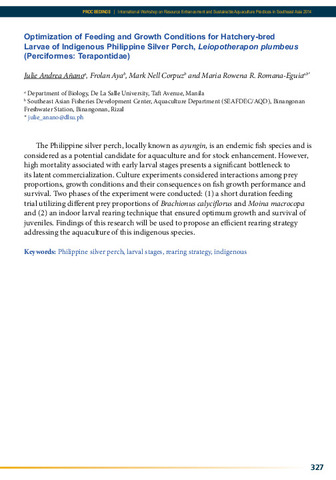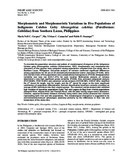Optimization of feeding and growth conditions for hatchery-bred larvae of indigenous Philippine silver perch, Leiopotherapon plumbeus (Perciformes: Terapontidae)
- Global styles
- MLA
- Vancouver
- Elsevier - Harvard
- APA
- Help
Share
Abstract
The Philippine silver perch, locally known as ayungin, is an endemic fish species and is considered as a potential candidate for aquaculture and for stock enhancement. However, high mortality associated with early larval stages presents a significant bottleneck to its latent commercialization. Culture experiments considered interactions among prey proportions, growth conditions and their consequences on fish growth performance and survival. Two phases of the experiment were conducted: (1) a short duration feeding trial utilizing different prey proportions of Brachionus calyciflorus and Moina macrocopa and (2) an indoor larval rearing technique that ensured optimum growth and survival of juveniles. Findings of this research will be used to propose an efficient rearing strategy addressing the aquaculture of this indigenous species.
Description
Abstract only.
Suggested Citation
Añano, J. A., Aya, F., Corpuz, M. N., & Romana-Eguia, M. R. R. (2015). Optimization of feeding and growth conditions for hatchery-bred larvae of indigenous Philippine silver perch, Leiopotherapon plumbeus (Perciformes: Terapontidae). In M. R. R. Romana-Eguia, F. D. Parado-Estepa, N. D. Salayo, & M. J. H. Lebata-Ramos (Eds.), Resource Enhancement and Sustainable Aquaculture Practices in Southeast Asia: Challenges in Responsible Production of Aquatic Species: Proceedings of the International Workshop on Resource Enhancement and Sustainable Aquaculture Practices in Southeast Asia 2014 (RESA) (p. 327). Tigbauan, Iloilo, Philippines: Aquaculture Department, Southeast Asian Fisheries Development Center.
Type
Conference paperISBN
9789719931041
Related items
Showing items related by title, author, creator and subject.
-
Bridging traditional knowledge with mainstream technology to sustain cultural and biological diversity in the product development of wild honey: Focus on the indigenous peoples of the Palawan Biosphere Reserve, Philippines
Declared a Man and Biosphere Reserve in 1991, the Palawan Biosphere Reserve in the Philippines is a biologically diverse province and home to a number of Indigenous Peoples particularly the Pala’wan, Tagbanua and Batak ... -
Screening of inexpensive and indigeneous ingredients for use in practical feed for juvile sea bass (Lates calcarifer Bloch)
Coloso, Relicardo M.; Hipolito, Jose Roy; Murillo, Deograce (Aquaculture Department, Southeast Asian Fisheries Development Center, 1996)An eight-week feeding experiment with juvenile sea bass (about 15 g) was conducted in 500-1 fiberglass tanks to screen the most cost-effective practical diet for use in ponds and floating cages. Eleven formulations and one ... -
Morphometric and morphomeristic variations in five populations of indigenous Celebes goby Glossogobius celebius (Perciformes: Gobiidae) from Southern Luzon, Philippines
Corpuz, Mark Nell C.; Camacho, Ma. Vivian C.; Ocampo, Pablo P. (College of Agriculture, University of the Philippines Los Baños, 2013)To elucidate the population structure and pattern of morphological divergence of the indigenous Celebes goby Glossogobius celebius (Valenciennes, 1837), morphometric and morphomeristic characters of this species were ...








